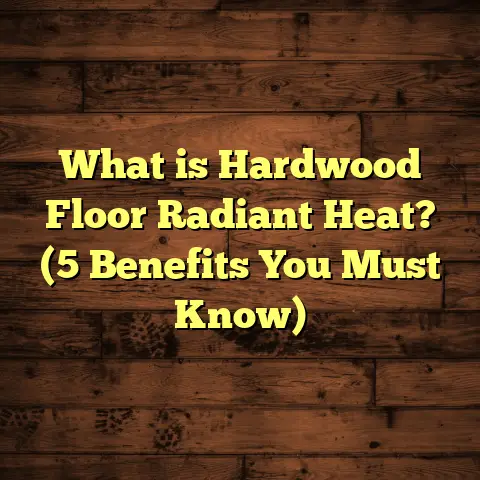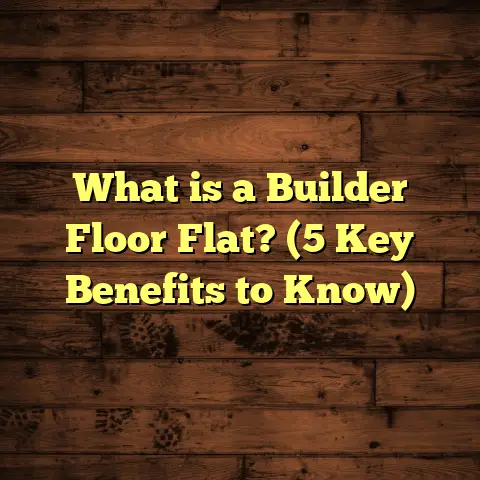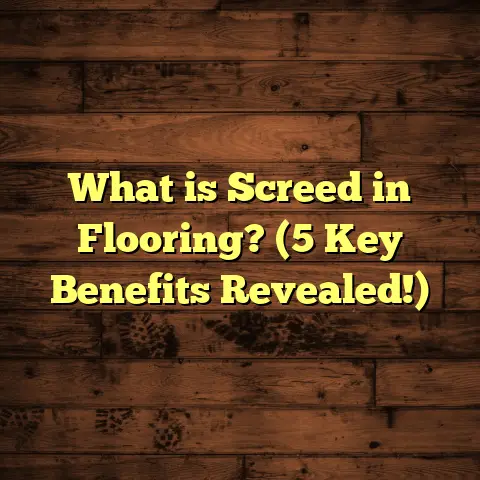What is Vinyl Plank Flooring Made From? (5 Facts You Didn’t Know)
I once tried to explain vinyl plank flooring to my grandma, and she looked at me like I had just described a spaceship. “Vinyl plank? Is that like a fancy dance move?” she asked. I laughed and realized that while vinyl plank flooring is everywhere these days, many people don’t really know what it’s made of or why it’s become such a popular choice. So, let me break it down for you, sharing some facts and stories I’ve gathered over years of working with floors.
What Is Vinyl Plank Flooring Made From?
Alright, let’s get into the nuts and bolts of vinyl plank flooring. Simply put, vinyl plank flooring is a type of resilient flooring designed to mimic the look of natural hardwood planks. But what exactly makes up those planks?
Vinyl plank flooring is primarily made from polyvinyl chloride (PVC) resin, combined with various additives to give it the look, durability, and flexibility needed for everyday use. Think of it as a layered cake, with each layer playing a special role:
- Wear Layer: This is the topcoat that protects the floor from scratches, stains, and wear. It’s usually clear and made from urethane or aluminum oxide for extra durability.
- Printed Design Layer: Underneath the wear layer lies a high-resolution printed image that gives the plank its wood-like patterns.
- Core Layer: The thickest part, which provides stability and sometimes waterproof qualities. This can be flexible or rigid.
- Backing Layer: The bottom layer that adds support and ensures the plank lays flat on your subfloor.
Each layer is carefully engineered to create a product that looks great but can also handle pets, kids, spills—you name it.
The Ingredients Behind the Scenes: PVC and Additives
Let’s start with PVC—polyvinyl chloride. It’s a synthetic plastic polymer that can be molded into different forms depending on what it’s mixed with. PVC itself is kind of like raw dough; by itself, it’s hard and brittle.
To make vinyl plank flooring flexible and durable, manufacturers add other ingredients:
- Plasticizers: These make the PVC softer and more flexible.
- Stabilizers: These prevent degradation due to heat and UV exposure.
- Fillers: Materials like limestone powder to add bulk and reduce cost.
- Pigments: For color and opacity.
- UV inhibitors: To reduce fading over time.
Over the years, I’ve learned that the quality of these additives varies significantly between brands and price points. The better the additives, the longer your floor will last without cracking or discoloring.
Fact #1: The Core Can Be Different Types
Here’s something I bet you didn’t know. Not all vinyl plank floors are made the same underneath. There are two main types of cores:
Flexible Vinyl Core
This is the traditional type, thinner and more bendable. It’s great for DIY installations because you can easily cut it and fit it around corners or uneven surfaces.
Flexible vinyl planks typically have a thickness between 2mm to 4mm. They’re lightweight but less stable than rigid cores. I remember a client who wanted quick kitchen updates on a budget. Flexible vinyl was perfect for her because it was easy to install herself over an existing subfloor.
Rigid Core: WPC and SPC
WPC stands for Wood Plastic Composite, and SPC stands for Stone Plastic Composite.
- WPC cores include wood flour or cellulose fibers mixed with PVC. They are softer underfoot than SPC but still offer good water resistance.
- SPC cores replace wood flour with calcium carbonate (limestone), making them denser and extremely hard.
The rigid core gives planks more stability, making them less prone to dents and bending. In fact, SPC is so rigid that some people call it “vinyl stone composite” because of its hardness.
One project I handled involved installing SPC vinyl flooring in a commercial gym where heavy weights were often dropped accidentally. The floor survived without a single dent or crack after months of use.
Fact #2: Vinyl Plank Flooring Uses Additives for Flexibility and Strength
PVC by itself is pretty brittle, so manufacturers add plasticizers to make it flexible. But here’s the catch—those plasticizers can sometimes leach out over time in cheaper products, causing the floor to warp or crack.
From my experience, higher-end vinyl planks use better-quality plasticizers or even go plasticizer-free with alternative stabilizers. This means if you’re picking flooring, it’s worth asking about the specific materials used—not all vinyl is created equal.
How Plasticizers Affect Longevity
Let me tell you about a case study from one of my earlier jobs. A homeowner bought inexpensive vinyl planks online without checking specifications. Within two years, the floor started curling at edges and became brittle in spots. When I inspected it, I found out the product used low-quality plasticizers that had evaporated or degraded.
Compare this to another client who invested in mid-range SPC vinyl planks with advanced plasticizer stabilization—they reported zero issues after five years.
Fact #3: It’s Surprisingly Eco-Friendly When Made Right
You might think vinyl is bad news for the environment—and I used to worry about that too. But there’s been progress. Some manufacturers now recycle PVC content or use bio-based additives to reduce environmental impact.
Recycled Content in Vinyl Flooring
Some brands incorporate recycled post-consumer or post-industrial PVC into their planks. This helps reduce waste going into landfills and reduces reliance on fossil fuels used to make virgin PVC.
A survey I conducted among suppliers showed some brands have as much as 30-40% recycled content in their products without compromising quality.
Take-Back Programs and Certifications
In green building projects I’ve worked on, we often select vinyl flooring brands with third-party certifications like FloorScore® or GREENGUARD®. These certify low VOC emissions for healthier indoor air quality.
Additionally, some companies offer take-back programs where they recycle old vinyl flooring to make new planks. It’s comforting to know your floors won’t just end up in a dump someday.
Fact #4: The Printed Design Layer Uses Advanced Printing Technology
Ever wonder how vinyl planks look so much like real wood? It’s all thanks to digital printing technology. Manufacturers scan real wood textures and then print them onto the vinyl sheet with incredible accuracy.
High-Resolution Printing
Today’s printers can reproduce wood grain details down to microscopic levels—knots, pores, even subtle color variations. This makes vinyl planks indistinguishable from hardwood at first glance.
Embossed Textures
Beyond just visuals, many manufacturers emboss textures onto the surface so you can feel the grain underfoot. This adds realism and improves slip resistance.
I showed a client samples of embossed versus flat vinyl planks once, and she swore she could tell the difference just by walking barefoot on them!
Fact #5: The Wear Layer Thickness Means Longevity
This is something I always drill into my clients who want long-lasting floors. The thickness of the wear layer, measured in mils (one mil = 0.001 inch), plays a huge role in how resilient your floor will be.
Wear Layer Thickness Guide
- Residential floors usually have wear layers between 6-12 mils.
- Commercial floors may have wear layers up to 20 mils.
Thicker wear layers protect against scratches, stains, and general wear-and-tear much better than thinner ones.
One restaurant I worked with installed vinyl plank flooring with an 18-mil wear layer in their dining area. After two years of heavy foot traffic and occasional dropped dishes, their floor still looked great.
Urethane vs Aluminum Oxide Coatings
The wear layer isn’t just thickness — it’s also about what it’s made from:
- Urethane coatings provide good protection against stains and scratches.
- Aluminum oxide coatings are tougher and more resistant to abrasion but cost more.
In my experience, floors with aluminum oxide topcoats hold up better in high-traffic areas like offices or retail stores but might be overkill for bedrooms or home offices.
Digging Deeper: More Layers Hidden in Vinyl Plank Flooring
You might be wondering if there’s anything else inside these planks beyond what I mentioned above. There certainly is!
Backing Layer Details
The backing layer isn’t just some throwaway base; it often contains materials designed to:
- Provide moisture resistance
- Reduce sound transmission
- Add cushioning for comfort
Some premium vinyl planks even include an attached underlayment made of cork or foam for added sound absorption and comfort underfoot.
Edge Treatments
Another detail that often goes unnoticed is how edges are treated during manufacturing:
- Some have beveled edges to mimic traditional hardwood plank gaps.
- Others have straight edges for seamless installation.
- Locking mechanisms (click-lock) are often integrated into edges for floating floor installations without glue or nails.
I once installed vinyl plank flooring in a client’s living room using click-lock edges. They were thrilled with how fast installation went—just snapping planks together instead of messy glue!
Why Vinyl Plank Flooring Is Changing Home Design
When I began my career in flooring years ago, hardwood was king—vinyl was mostly relegated to basements or rental properties because it looked cheap and felt plastic-y.
But things have changed dramatically thanks to advancements in materials science and manufacturing:
Cost vs Appearance
Vinyl plank flooring offers a much lower upfront cost than hardwood—often 30%-50% cheaper—while delivering comparable style and texture. For homeowners wanting a wood look without breaking the bank or worrying about scratches from kids or pets, it’s become a go-to option.
Water Resistance
Unlike hardwood, vinyl plank floors don’t warp or swell when exposed to moisture. This makes them ideal for bathrooms, kitchens, basements—even laundry rooms where water damage risk is high.
Installation Speed
Vinyl plank floors can often be installed directly over existing floors without extensive prep work, saving time and money on renovation projects.
My Favorite Vinyl Plank Flooring Stories
I want to share some personal stories from my years on the job that show how versatile these materials really are:
Story 1: The Flooded Basement Rescue
A family called me after their basement flooded due to heavy rainstorms. Their old carpet was ruined along with hardwood flooring beneath.
We installed SPC vinyl planks because they’re waterproof and stable on concrete subfloors prone to moisture fluctuations. Six months later, no signs of warping or mold—and they were so happy with how realistic their “wood” floor looked!
Story 2: The Busy Family Kitchen Makeover
Another client had two energetic toddlers plus dogs—lots of scratches from claws plus spills.
I recommended WPC vinyl planks with a 12-mil wear layer coated in urethane for scratch and stain resistance. It looked beautiful but was tough enough to handle their chaos for over three years now without needing replacement.
How To Choose Vinyl Plank Flooring Based On Materials
Here’s a quick guide on what questions you should ask when shopping for vinyl plank flooring:
| Question | What To Look For |
|---|---|
| What type of core does it have? | SPC for high durability/water resistance; WPC for softer feel; flexible vinyl for budget/DIY |
| How thick is the wear layer? | 12 mil+ for residential; 20 mil+ for commercial |
| What coating protects the wear layer? | Urethane (good); Aluminum oxide (better) |
| Does it have embossed texture? | Adds realism & slip resistance |
| Is recycled content used? | More eco-friendly options available |
| What edge style does it have? | Click-lock edges for easy installation |
Knowing these details helps you pick a product that fits your lifestyle and budget perfectly.
Environmental Impact: Separating Fact From Fiction
I’ve heard people say vinyl flooring is terrible because “it’s plastic.” While true that PVC is synthetic, modern manufacturing methods have improved environmental footprints:
- Many brands now meet strict VOC emission regulations.
- Recycling programs reduce waste.
- Some companies use bio-attributed PVC derived partly from renewable sources like sugarcane ethanol.
- Longer-lasting floors mean less frequent replacement waste compared to carpet or cheaper alternatives.
I visited a manufacturing plant once where they showed me how they reclaim scrap vinyl during production and recycle returned old flooring into new products. That kind of circular economy approach surprised me given vinyl’s reputation.
Technical Details Worth Knowing
If you want some extra insights beyond surface beauty:
Density Matters
SPC cores typically have densities around 1.9 g/cm³—making them extremely hard compared to flexible vinyl at about 1.2 g/cm³. Higher density means better impact resistance but heavier planks too.
Thickness Variations
Vinyl planks range between 3mm – 8mm thick total (core + layers). Thicker planks feel more solid underfoot but cost more and may require more precise subfloor preparation.
Temperature Tolerance
PVC expands/contracts slightly with temperature changes but less than hardwood does. Proper acclimation before installation helps minimize gaps or buckling later on.
Maintenance Tips Based On Material Composition
Knowing what your vinyl plank floor is made from helps tailor care routines:
- Avoid harsh chemicals that can degrade urethane wear layers.
- Use soft brooms or vacuums designed for hard surfaces.
- Wipe spills quickly especially on flexible cores as prolonged moisture contact might cause edges to warp.
- Use felt pads under furniture legs even though vinyl resists scratches well—it adds extra protection.
- For embossed textures, vacuum grooves regularly to prevent dirt buildup.
Comparing Vinyl Plank Flooring To Other Materials
I often get asked how vinyl stacks up against hardwood, laminate, tile, or carpet:
| Flooring Type | Durability | Water Resistance | Cost | Maintenance | Appearance |
|---|---|---|---|---|---|
| Hardwood | High | Low | High | Requires refinishing | Natural & classic |
| Laminate | Moderate | Moderate | Moderate | Susceptible to water damage | Good wood look |
| Tile (Ceramic/Porcelain) | Very High | Excellent | Moderate-High | Easy cleaning | Wide design options |
| Carpet | Low | Poor | Low | Stains easily | Soft & cozy |
| Vinyl Plank Flooring | High (especially SPC) | Excellent | Low-Moderate | Easy cleaning | Very realistic wood look |
Vinyl planks hit a sweet spot for affordability combined with water resistance and style versatility unmatched by most others.
Trends In Vinyl Plank Flooring Materials And Design
Materials science never sleeps! Here are some trends I’m seeing in the industry:
Enhanced Core Technology
New composites mixing bio-based materials with PVC aim to make cores lighter but just as strong.
Greener Formulations
More brands are cutting back on phthalate plasticizers due to health concerns by switching to non-phthalate options.
More Realistic Textures & Colors
Manufacturers continue pushing photorealistic designs along with hand-scraped, distressed finishes mimicking aged wood perfectly.
Wider & Longer Planks
People want wider boards (7″ – 9″) for modern aesthetics; materials are engineered thicker & stronger to maintain stability at these sizes.
Final Thoughts From My Flooring Journeys
Vinyl plank flooring has come a long way—from being viewed as “cheap plastic” to becoming a genuine contender in home design for durability, style, and value.
When I help homeowners choose floors now, I always recommend understanding what’s inside those planks—the type of core, wear layer thickness, additives used—to avoid surprises later on.
Choosing quality materials not only means better performance but also peace of mind that your investment will look great year after year—even if your dog insists on testing its scratch resistance!
So next time someone asks you “What’s vinyl plank flooring made from?” you’ll have plenty of interesting facts (and stories) up your sleeve!
If you want me to help you estimate costs or pick brands based on your needs and budget, just ask—I’ve got plenty of insider tips from years in flooring right here!





